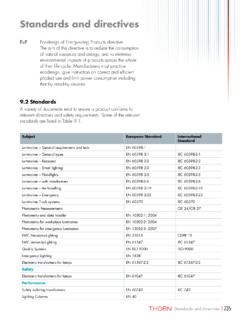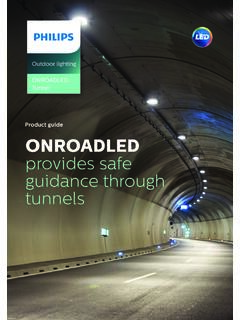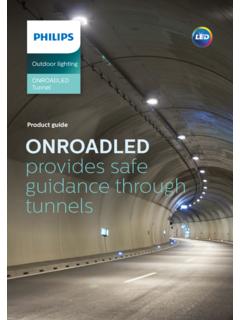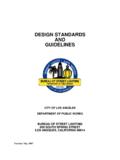Transcription of Tunnel lighting
1 Tunnel lighting22 ContentsIntroduction2 - 3 Tunnel lighting criteria4 - 5 Types of Tunnel lighting6 - 9 Thorn expertise10 Controlling Tunnel lighting11 Product testing12 Products13 - 15 Case studies16 - 17 Applications gallery18 International references19As our road networks become more crowded, the use oftunnels and underpasses is expanding, both to improvetraffic flow, and to protect local environments fromincreased traffic tunnels, where maintenance access can be limited,and where corrosive atmospheric conditions are common,reliable performance of the lighting system is critical, as isthe need for the absolute minimum of operationalmaintenance objectives of Tunnel lightingThe aims of Tunnel lighting are.
2 Firstly, to allow traffic to enter, pass through and exit the enclosedsection safely Secondly, to do so without impeding the through-flow of aims are achieved by the adequate illumination of the tunnelinterior, which allows drivers to quickly adjust to the light within,identify possible obstacles, and negotiate their passage withoutreducing requirements apply during the day when the contrast betweenoutside and inside is significant and at night when it is less, Threshold zone1 Access zoneStoppingpointDirection of travelStoppingdistance (SD)L20 (outside luminance) Lth(thresholdluminance)AdaptationpointAP ortal4 Tunnel lighting criteriaThe 5 zones of tunnellightingCIE guidance (CIE 88-1990)states that the amount of lightrequired within a Tunnel isdependent on the level of lightoutside and on the point insidethe Tunnel at which visualadaptation of the user mustoccur.
3 When planning the lighting of atunnel, there are 5 key areas toconsider:1 Access zoneNot within the Tunnel itself, this isthe stretch of road leading to this zone, drivers must beable to see into the Tunnel inorder to detect possible obstaclesand to drive into the tunnelwithout reducing driver s capacity to adapt inthe access zone governs the the level required in the interiorzone. The reduction stages mustnot exceed a ratio of 1:3 as theyare linked to the capacity of thehuman eye to adapt to theenvironment and, thus, time-related. The end of the transitionzone is reached when theluminance is equal to 3 times theinterior Interior zoneThis is the area betweentransition and exit zones, oftenthe longest stretch of levels are linked to thespeed and density of traffic, asoutlined in the table to be maintained in interior zoneExtra urban, low traffic, low speed (<70km/h) to 3cd/m2 Extra urban, high traffic and/or speed (>70km/h) 2 to 6cd/m2 Highway4 to10cd/m2 Urban4 to10cd/m2lighting level in the next part ofthe Tunnel .
4 One of the methodsused by CIE to calculate visualadaptation is the L20method,which considers the averageluminance from environment, skyand road in a visual cone of20 , centred on the line of sightof the driver from the beginningof the access zone (see below).2 Threshold zoneThis zone is equal in length to the stopping distance . In the firstpart of this zone, the requiredluminance must remain constantand is linked to the outsideluminance (L20) and trafficconditions. At the end of thezone, the luminance levelprovided can be quickly reducedto 40% of the initial Transition zoneOver the distance of thetransition zone, luminance isreduced progressively to reach5 Exit zoneThe part of the Tunnel betweeninterior zone and portal.
5 In thiszone, during the day time, thevision of a driver approachingthe exit is influenced bybrightness outside the Tunnel . The human eye can adapt itselfalmost instantly from low to highlight levels, thus the processesmentioned when entering thetunnel are not , reinforced lighting maybe required in some cases wherecontrast is needed in front of orbehind the driver when the exit isnot visible, or when the exit actsas entrance in case of emergencyor maintenance works where partof a twin Tunnel may be length is a maximum 50mand the light level 5 times theinterior zone Tunnel lighting allows users to enter, pass through and exit the enclosed section safely and comfortablyStopping distanceA20 10 1.
6 Spatial adaptation:the largedifference in luminance betweenthe outside and the inside of thetunnel will impede the vision ofthe driver when he is at theadaptation point ( A , opposite).The Black Hole phenomenonengenders a feeling of discomfort and adjustmentThe visual adjustment from highluminance to low luminancewhile driving is is cause of 2disability phenomena:2. Temporal adaptation:humaneyes need more time to adaptfrom brightness to darkness thanthe reverse. During this period ofadaptation, the distance travelledis a critical Transition zone4 Interior zone5 ExitzoneParting zone2 x SDLtr(transitionluminance)Lin(interior luminance)Lex(exit luminance)Portal5 Entrance and exit portalsThe entrance portal of the Tunnel is the partof the Tunnel construction that corresponds tothe beginning of the covered part of thetunnel, or - when open sun-screens are used -to the beginning of the sun-screens.
7 The exitportal corresponds to the end of the coveredpart of the Tunnel , or - when open sun-screens are used - to the end of the zoneThe exit zone is the part of the Tunnel where,during the daytime, the vision of a driverapproaching the exit is predominatelyDefinitionsAccess zone luminance L20 The average value of the luminance in a 20 cone of the driver s visual field from theaccess zone and centred on the revealing coefficient qcThe ratio between the luminance at the roadsurface and the vertical illuminance Ev at aspecific location in the Tunnel qc=L/Ev. Themethod of Tunnel lighting may be defined interms of the contrast ratio in three ways:symmetric lighting , counterbeam lighting andpro-beam lighting (see pages 6 - 7).
8 Influenced by the brightness outside thetunnel. The exit zone begins at the end ofthe interior zone. It ends at the Tunnel s zone luminance (Lin) The average luminance in the interior zonewhich constitutes the background fieldagainst which objects will be visible zone The parting zone is the first part of the openroad directly after the exit. The parting zoneis not a part of the Tunnel but it is closelyrelated to the Tunnel lighting . It is advisedthat the length of the parting zone equalstwo times the stopping distance. A length ofmore than 200m is not point (SP)The position within the access zone on theapproach road at a distance equal to thestopping distance (SD) from the distance (SD)The theoretical forward distance required bya driver at a given speed in order to stopwhen faced with an unexpected hazard onthe carriageway.
9 This takes into account perception andreaction time as well as road zone luminance (Lth)The average luminance in the threshold zonewhich constitutes the background fieldagainst which objects will be visible todrivers in the access zone between thestopping point and adaptation flowThe number of vehicles passing a specificpoint in a stated time in stated direction(s).In Tunnel design, peak hour traffic, vehiclesper hour per lane, will be zone luminance (Ltr) The average luminance in the transition zone which constitutes the background fieldagainst which objects will be visible to luminanceThe overall luminance veil consisting of thecontribution of the transient adaptation andstray light from optical media, from theatmosphere and from the vehicle road lighting must provide comfort and safety and maximise the visual performance of of Tunnel lightingSymmetrical andasymmetrical lighting Used generally for transition andinterior zones for long tunnels,and in short tunnels.
10 Or lowspeed tunnels for all lighting can alsobe a means of reinforcing theluminance level in one counter beamlightingTo reinforce the luminance leveland at the same time accentuatethe negative contrast of potentialobstacles. Counter beam lightingis achieved with asymmetricallight distribution facing into thetraffic flow, both in the directionof the on coming driver and inthe run of the road . The beamstops sharply at the vertical planepassing through the light is directed with the flowof traffic. This generates negativecontrast and enhances visualadaptation. Pro beam lightingIn some circumstances, positivecontrast must be reinforced, often in the exit zone where theexit is visible.










